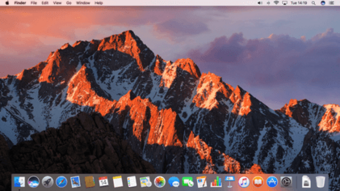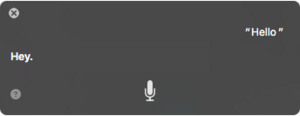- This page was last modified on 17 October 2025, at 10:18. Suggest an edit.
macOS Sierra facts for kids
"macOS 10.12" redirects here. For macOS 12, see macOS Monterey.
| Version of the macOS operating system | |

macOS Sierra desktop
|
|
| Developer | Apple Inc. |
|---|---|
| OS family | |
| Source model | Closed, with open source components |
| General availability |
September 20, 2016 |
| Latest release | 10.12.6 (16G2136) / September 26, 2019 |
| Repository |
|
| Update method | Mac App Store |
| Platforms | x86-64 |
| Kernel type | Hybrid (XNU) |
| License | APSL and Apple EULA |
| Preceded by | OS X El Capitan |
| Succeeded by | macOS High Sierra |
| Tagline | What can your Mac do now? Just ask. |
| Support status | |
| Obsolete, unsupported as of September 2019. iTunes is no longer being updated, but is able to download driver updates to sync to newer devices. Drops support for Macs released from mid 2007 to mid 2009. | |
macOS Sierra (version 10.12) is a big update for macOS. This is the computer operating system made by Apple Inc. for their Macintosh computers. Before Sierra, it was called OS X. Apple changed the name to "macOS" to match their other systems like iOS (for iPhones), watchOS (for Apple Watch), and tvOS (for Apple TV).
Sierra is named after the Sierra Nevada mountain range in California and Nevada. This version brought cool new features. These included better ways for Apple devices to work together (called Continuity). It also improved iCloud and how you manage windows on your screen. Plus, it added support for Apple Pay and Siri.
The first test version of macOS Sierra came out for developers on June 13, 2016. A public test version followed on July 7, 2016. Apple released it to everyone on September 20, 2016. It was a free update you could get from the Mac App Store. Later, macOS High Sierra replaced it on September 25, 2017.
Contents
What Macs Can Run macOS Sierra?
To run macOS Sierra, your Mac needs at least 2 GB of RAM (computer memory). It also needs 8 GB of storage space. It works on these Mac models:
- iMac (Late 2009 or newer)
- MacBook (Late 2009 or newer)
- MacBook Air (Late 2010 or newer)
- MacBook Pro (Mid 2010 or newer)
- Mac Mini (Mid 2010 or newer)
- Mac Pro (Mid 2010 or newer)
Sierra stopped supporting some older Macs from mid-2007 to mid-2009. This was the first time a macOS version did this since OS X Mountain Lion in 2012. Support for Xserve computers was also removed.
How to Install on Older Macs
Some clever developers found ways to install macOS Sierra on Macs that Apple no longer officially supports. This works if the Mac has a CPU that supports something called SSE4.1. You need to use a special patch to change the installation file.
New Features in macOS Sierra
macOS Sierra brought many exciting changes and improvements.
Default Look
The main desktop picture for macOS Sierra is a beautiful image of Lone Pine Peak.
System Tools
Siri: Your Mac's Smart Assistant
Now, you can talk to Siri on your Mac! You can open Siri from the Dock, the menu bar, or by using a keyboard shortcut. Siri's answers show up in a window in the top-right corner of your screen.
Siri can help you send messages, search the internet, find files, and change settings. You can even drag things Siri finds into other apps. For example, you could drag pictures from a search directly into a document.
iCloud Drive & Smart Storage
With iCloud Drive, you can save your documents and desktop files to the cloud. This means they automatically sync to your other Apple devices. The System Information app now shows you how much space each app or file uses. It also gives you tips to free up space.
For example, your Mac can upload old files to iCloud Drive and remove them from your computer. They will still be available whenever you need them in Finder. It can also automatically empty your trash. iTunes can even delete movies and TV shows you've watched and bought to save space.
Auto Unlock & Universal Clipboard
These features make your Apple devices work even better together. They use Bluetooth and Wi-Fi to connect.
- Auto Unlock: You can unlock your Mac just by wearing your paired Apple Watch and being close to your computer. This feature works on Macs made in 2013 or later.
- Universal Clipboard: You can copy something on your Mac and paste it on your iPhone or iPad (running iOS 10). This works for text, pictures, and even videos!
Tabs and Picture-in-Picture
- Tabs: Many apps that usually open multiple windows can now use tabs inside one window. This helps keep your screen tidy, just like tabs in Safari.
- Picture-in-Picture: You can play videos in a small window that stays on top of everything else. This window follows you even if you switch to other apps.
Apple File System (APFS)
Apple showed off a new file system called Apple File System (APFS) in Sierra. This new system is designed for modern solid-state drives and flash memory. It has cool features like snapshots (saving a moment in time) and cloning (making quick copies). It also supports file encryption and TRIM (which helps SSDs last longer). APFS was fully released in macOS High Sierra.
Night Shift
Night Shift came with macOS 10.12.4. It works just like the feature on iPhones and iPads. Night Shift makes your screen show less blue light at night. This can help you sleep better. You can set it to turn on automatically in System Preferences or turn it on and off with Siri. Not all Macs that run Sierra can use Night Shift, as it needs a special graphics feature called Metal.
Application Updates
Photos App Gets Smarter
The Photos app got better at recognizing faces, objects, and scenes. It can group similar pictures together to create "memories." These memories are like mini-slideshows with music and transitions chosen by the app. You can also change them if you like. The "People" album organizes photos by the people in them, and "Places" shows all your photos on a world map.
Safari and Apple Pay
Safari now lets developers create extensions that work directly with their apps. Safari also hides old plug-ins like Adobe Flash Player from websites. You have to choose to enable them for specific websites.
Apple Pay lets you buy things online using your Mac. When you see an Apple Pay button on a website in Safari, you can click it. Then, you complete the purchase using your iPhone or Apple Watch. To use Apple Pay on your Mac, you need a Mac from 2012 or later. You also need an iPhone 6 or newer (with iOS 10) or an Apple Watch (with watchOS 3).
Messages App Fun
The Messages app got some fun new effects. You can send emojis that are three times bigger. You can also add reactions like hearts or thumbs-up to message bubbles. You can now watch YouTube videos and see previews of links right inside your conversations. Plus, you can see interactive content sent from iMessage on iOS 10. You can also choose to turn read receipts on or off for each conversation.
iTunes Redesign
Apple Music inside iTunes got a new look. It's now easier to find your favorite songs and discover new music. There's a new "For You" tab that suggests music you might like. The MiniPlayer (a small music player) was also improved, and you can now see lyrics while listening to songs.
Other Cool Changes
- Disk Utility can now manage RAID sets again. This feature was removed in the previous version, El Capitan.
- Finder has an option to always show folders at the top of your file lists.
- Mail added a quick filter at the top of your email list. You can easily sort emails by if they're read or if they have attachments.
- 13-inch and 15-inch Retina MacBook Pros now show more content on their screens by default.
Security Updates
Gatekeeper: Keeping Your Mac Safe
Gatekeeper is a security feature that helps protect your Mac from harmful software. In macOS Sierra, Gatekeeper changed a bit. It now hides the "Anywhere" option in System Preferences. This option used to let you run programs from any source without approval.
Apple also added new ways for developers to "sign" their software. This helps your Mac check if the software is safe and hasn't been changed by someone trying to cause trouble. For example, developers can now sign entire disk images. This means your Mac can check if all the files inside are safe.
Another new feature is "path randomization." This makes apps run from a hidden, random spot. This helps stop bad programs from finding and messing with other files on your computer.
Permissions and Sudo
The `/Volumes` directory, where external drives appear, now has stricter permissions. Only the root (the main system user) can write to it. This makes it harder for bad software to make changes there.
Apple also made changes to a system directory that lists apps allowed to "control the computer." Now, only programs signed by Apple can write to this list. This helps prevent other apps from secretly adding themselves to this powerful list.
The sudo command (which lets you run commands as another user, usually the root) now has a "tty_tickets" setting. This means that if you use `sudo`, your permission only lasts for that specific window or tab you're using.
Images for kids
See also
 In Spanish: MacOS Sierra para niños
In Spanish: MacOS Sierra para niños



